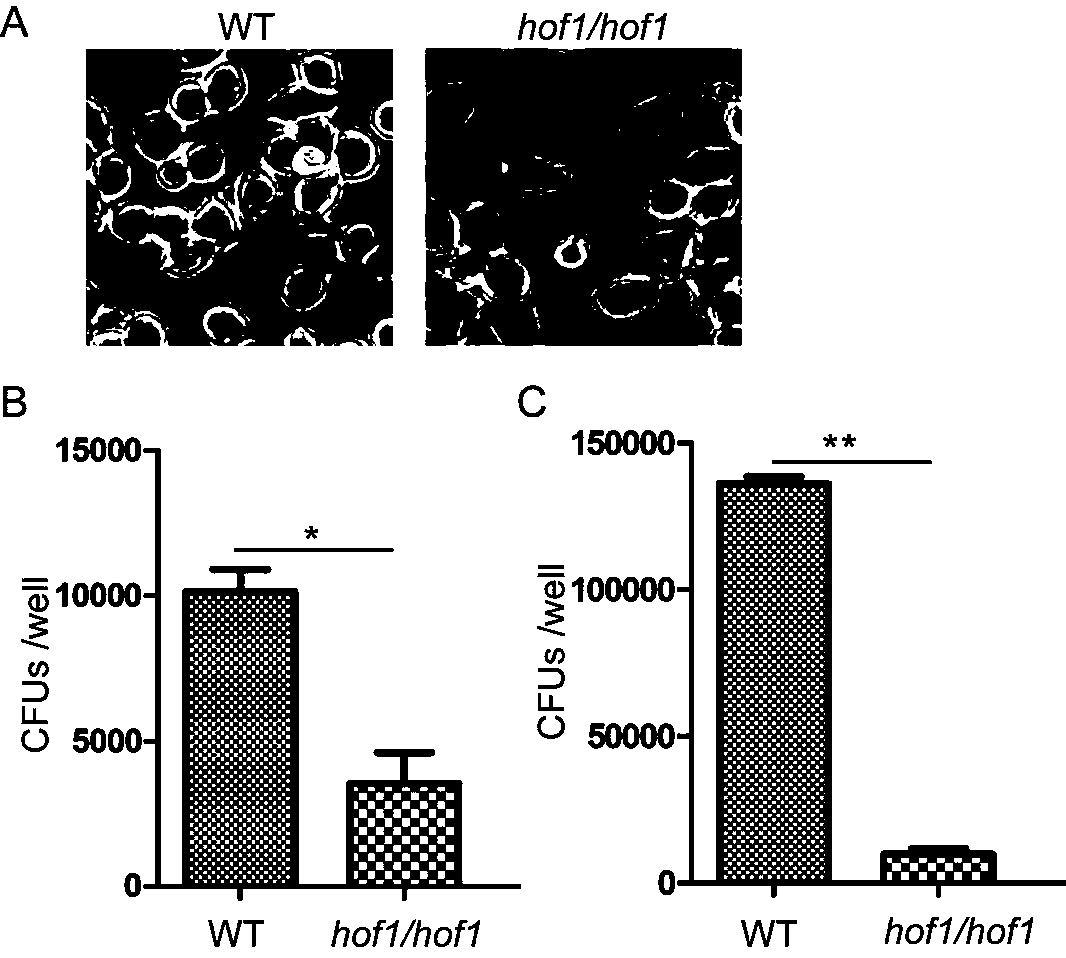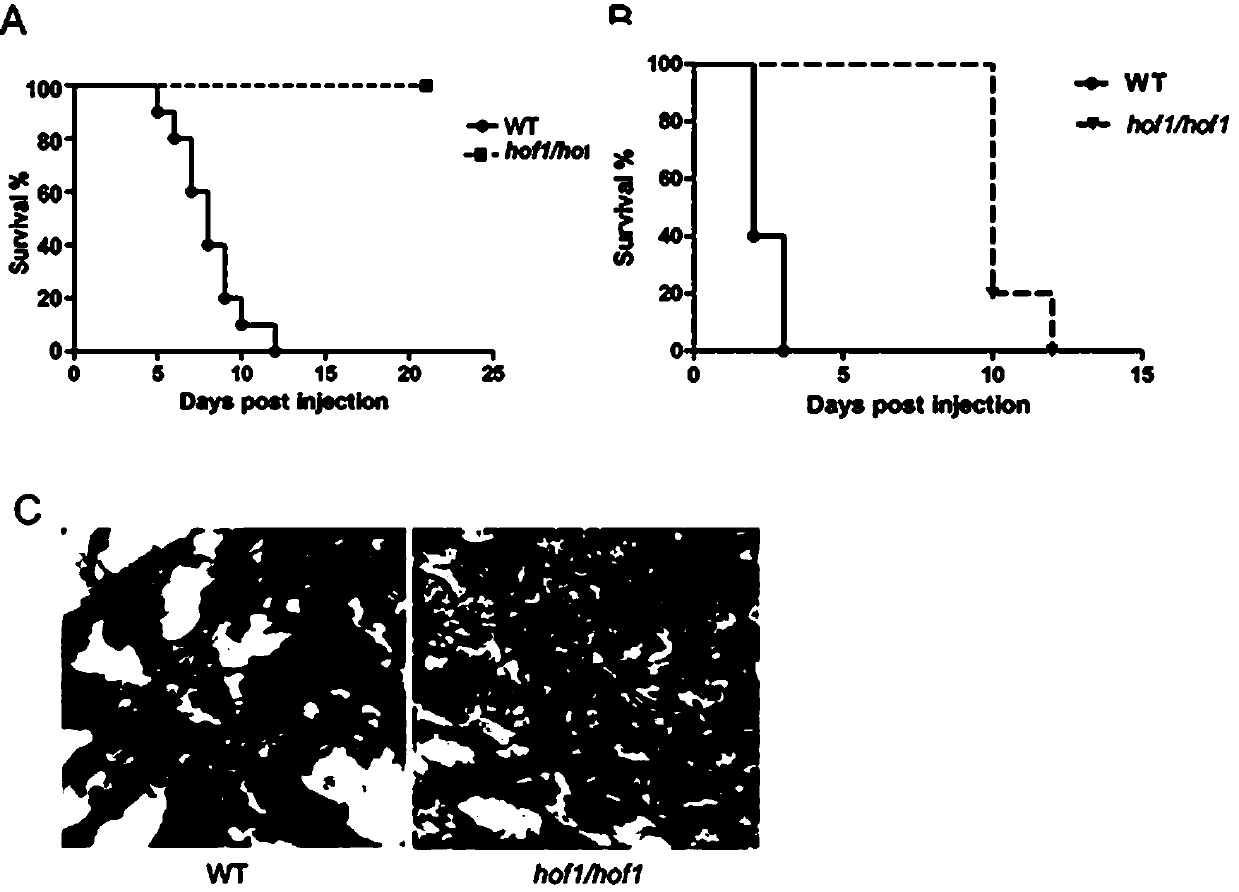Application of candida albicans attenuated strain without HOF1 gene
A technology for Candida albicans and deletion strains, applied in the direction of microorganism-based methods, medical preparations containing active ingredients, bacteria, etc., can solve the problems of loss and weakening of virulence, and achieve the effect of reduced toxicity and reduced viability
- Summary
- Abstract
- Description
- Claims
- Application Information
AI Technical Summary
Problems solved by technology
Method used
Image
Examples
Embodiment 1
[0026] Example 1 HOF1 Effects of gene deletion on the survival of Candida albicans in host cells
[0027] to prove HOF1The function of the missing Candida albicans in interacting with host cells, the present invention carried out the co-cultivation experiment of Candida albicans and macrophages (RAW264.7). Will 5×10 5 Macrophages were seeded into 12-well plates and incubated at 37°C in 5% CO 2 For overnight culture in medium, the wild-type strain of Candida albicans and HOF1 For the deletion strain, unbound Candida albicans was washed away after 2 hours, some of the macrophages were lysed with 0.01% SDS, diluted appropriately and spread on the YPD plate; the rest of the cells continued to be cultured for 6 hours, and the cells were lysed and spread in the same way flat. All the plates were cultured at 30°C for 2 days, and the number of colonies was counted, and the wild bacterial strain and HOF1 Growth of the deletion strain.
[0028] The results are as follows: after...
Embodiment 2
[0029] Example 2 HOF1 Deleted Candida albicans is significantly less virulent
[0030] to prove HOF1 For the effect of deletion on virulence regulation, the present invention has carried out mouse toxicity experiments. 1×10 6 Candida albicans wild strain and HOF1 The cells of the deletion strain were injected into Balb / c mice, and the survival rate was observed-, the results were as follows figure 2 As shown in A, it was found that the wild-type strain began to die on the 5th day, and all mice infected with the wild-type strain died on the 12th day; HOF1 The mice of the deletion strain remained alive until the end of the 21-day observation period, showing a significant reduction in virulence; in addition, the present invention also added high concentrations of (2×10 6 ) wild strain of Candida albicans and HOF1 Inject the cells of the deletion strain into Balb / c mice and observe the survival rate (such as figure 2 Shown in B), after the wild-type strain was injected ...
Embodiment 3
[0032] Example 3 HOF1 Gene deletion affects kidney colonization by Candida albicans
[0033] to prove HOF1 Genetic influence on visceral colonization by Candida albicans. 2×10 6 Candida albicans wild strain and HOF1 The cells of the deletion strain were injected into three five-week-old Balb / c mice, and the right kidney was collected 48 hours later. After being ground and homogenized, it was appropriately diluted and spread on a YPD plate. After culturing at 30°C for 2 days, the number of colonies was counted. The result is as image 3 As shown, in the mice infected with the wild-type strain, the bacterial content in the kidney was 8.1×10 5 / g; while infected HOF1 In mice with the deletion strain, the bacterial content in the kidney was only 1.6×10 3 / g. This result shows that, HOF1 Deletion of the gene significantly affected the ability of Candida albicans to colonize the kidney.
PUM
 Login to View More
Login to View More Abstract
Description
Claims
Application Information
 Login to View More
Login to View More - R&D
- Intellectual Property
- Life Sciences
- Materials
- Tech Scout
- Unparalleled Data Quality
- Higher Quality Content
- 60% Fewer Hallucinations
Browse by: Latest US Patents, China's latest patents, Technical Efficacy Thesaurus, Application Domain, Technology Topic, Popular Technical Reports.
© 2025 PatSnap. All rights reserved.Legal|Privacy policy|Modern Slavery Act Transparency Statement|Sitemap|About US| Contact US: help@patsnap.com



